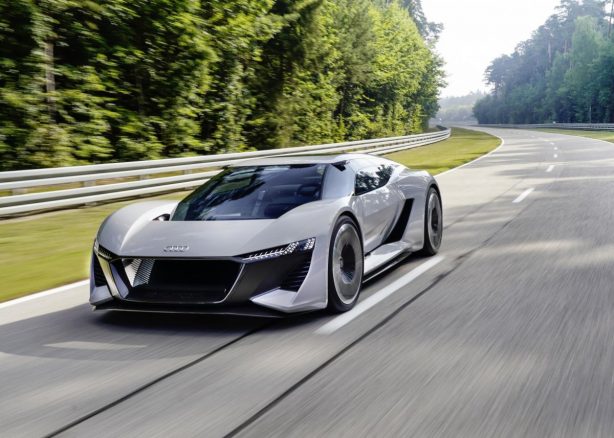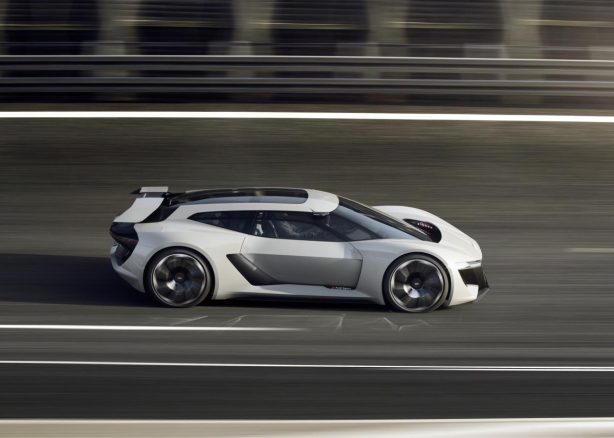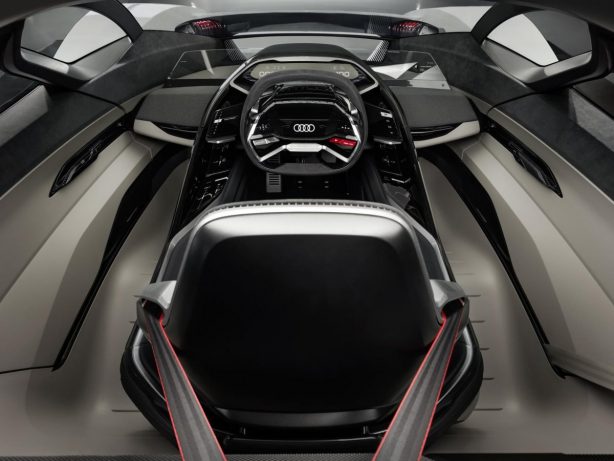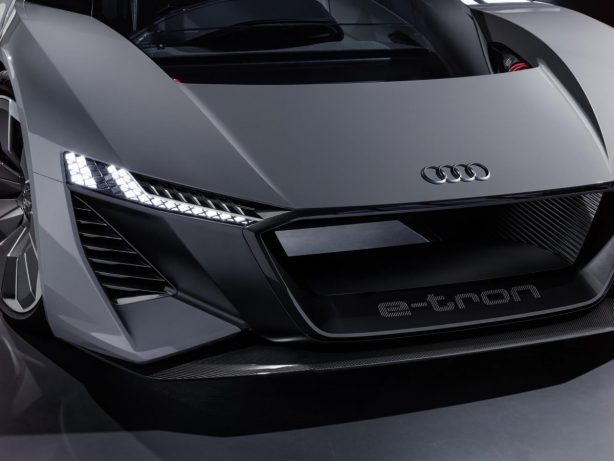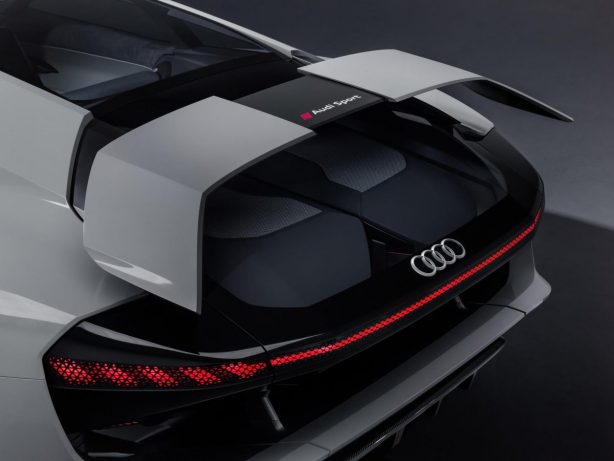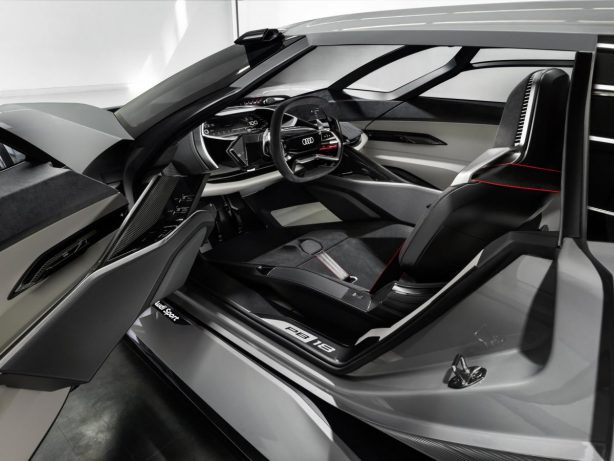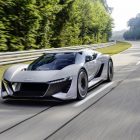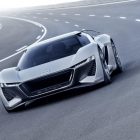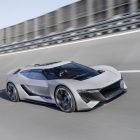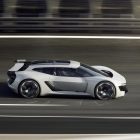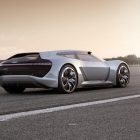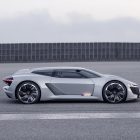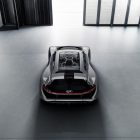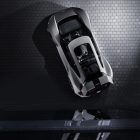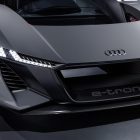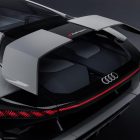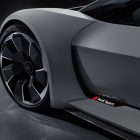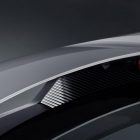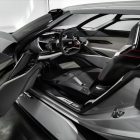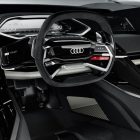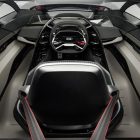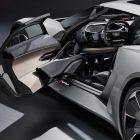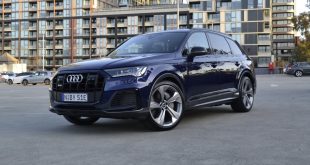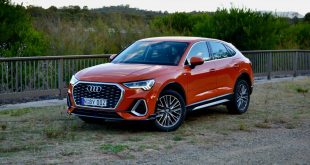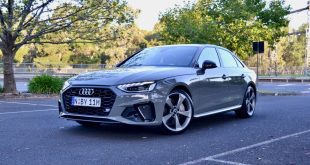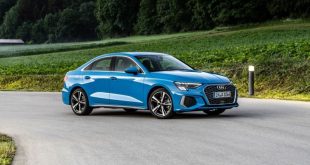Audi has unveiled its radical PB18 e-tron concept at the Pebble Beach Automotive Week in Monterey, California.
Conceived and created in the new Audi design studio in Malibu, California, the PB18 e-tron is a technical and design concept inspired by Audi’s Le Mans racing programme, specifically the Audi R18 e-tron LMP1 racer.
At first sight, the PB18 e-tron shows its kinship with the Audi Aicon concept from 2017, not only for design elements like the side windows that angle inwards and the significantly extended wheel arches, but also their all-electric drivetrains using advanced solid-state battery technology for energy storage.
But while the Aicon was designed as a fully autonomous, luxury vehicle, the PB18 e-tron was created as a driving machine for the racetrack and road. Audi says dynamics and emotion plays a crucial role in that regard.
To emphasis this, Audi’s internal working title for the project was “Level Zero” to differentiate it from the brand’s Level 3, 4 and 5 of autonomous driving projects.
In the Audi PB18 e-tron, the driver is the absolute centre of attention. There are therefore no complex systems for piloted driving on board and no comfort features to add weight. In their place are a driver’s seat and cockpit that are integrated into an inner monocoque shell that is moveable laterally depending on how many occupants are on board. When driven solo, the monocoque can be positioned in the centre of the interior as in a monoposto – the perfect location for the racetrack. This is made possible by the by-wire design of the steering and pedals.
Gael Buzyn Head of Audi Design Loft in Malibu describes the most important item in the specifications: “We want to offer the driver an experience that is otherwise available only in a racing car like the Audi R18. That’s why we developed the interior around the ideal driver’s position in the centre. Nevertheless, our aim was to also give the PB18 e‑tron a high degree of everyday usability, not just for the driver, but also for a potential passenger.”
When the driver’s monocoque is moved into the side position in everyday driving like a conventional road vehicle, there is room for a passenger. An additional seat can be accessed on the other side, integrated low above the ground and equipped with a three-point seatbelt. The driver also benefits when getting in and out from the easily accessible outside position of the monocoque, which can be moved when the door is open up to the sill.
The Audi PB18 e-tron package follows the traditional architecture of a mid-engine sports car with a cab that is positioned far forward. The car’s centre of gravity is located behind the seats and in front of the rear axle – which benefits the driving dynamics. This does not involve the engine-transmission unit, as in a car with a conventional drive system, but rather the battery pack.
A mix of aluminium, carbon and multi-material composites ensures the body of the Audi PB18 e-tron has a low basic weight, not least thanks to the innovative and comparatively light solid-state battery. A total weight of less than 1,550 kg (3,417.2 lb) can be expected.
The PB18 e-tron is 4.53 metres long, 2 metres wide and just 1.15 metres tall, sitting a 2.70 metres wheelbase. Viewed from the side, the eye is drawn to the gently sloping roof line which is pulled far to the back and features massive C-pillars. Together with the large and almost vertical rear window, this design is reminiscent of a shooting brake concept. The result is not only a distinctive silhouette but also a clear bonus in terms of its 470 litres cargo space, which is usually at a premium in sports cars.
A flat red band of lights extends across the entire width of the rear and underscores the horizontal orientation of the vehicle body. The cabin, placed on the broad shoulders of the wheel arches, appears almost dainty from the rear. The rear diffuser air outlet has been raised high – another functional feature borrowed from motorsport. The diffuser can be moved downwards mechanically to increase downforce, and the rear spoiler can be extended rearwards for the same purpose.
The widely extended wheel arches emphasise the extremely wide track of the quattro PB18 e-tron. The large 22-inch wheels, each with eight asymmetrically designed spokes, are reminiscent of turbine inlets – together with the air inlets and outlets of the wheel arches, their rotation ensures excellent air supply to the large carbon brake discs.
The front is dominated by the familiar hexagon shape of the Singleframe grille, with an emphatically wide and horizontal cut. The brand logo is positioned on the bonnet, in the typical Audi sports car style. Large air inlets to the left and right of the Singleframe supply the necessary cooling air to the brakes and the front electric motor. Wide and flat light units with integrated digital matrix technology and laser high-beam headlights complete the face of the PB18 e-tron.
Inside, the large-format cockpit is designed as a freely programmable unit and can be switched between various layouts for the racetrack or the road, depending on the scenario for use.
The concept uses three electric motors – one up front and two in the rear. The latter are centrally located between the steering knuckles, each directly driving one wheel via half-shafts. They deliver up to 150 kW of power to the front axle and 350 kW to the rear. Maximum output is 500 kW, but with boosting the driver can temporarily mobilise up to 570 kW. The combined torque of up to 830 Nm (612.2 lb-ft) allows acceleration from 0 to 62mph in scarcely more than 2 seconds – a speed that differs only marginally from that of a current LMP1 prototype.
While being driven, the Audi PB18 e-tron recovers large amounts of energy: up to moderate braking, the electric motors are solely responsible for decelerating the vehicle. The hydraulic brakes only come into play for heavy braking.
The liquid-cooled solid-state battery has an energy capacity of 95 kWh. A full charge provides for a range of over 310 miles in the WLTP cycle. The Audi PB18 e-tron is already designed for charging with a voltage of 800 volts. This means the battery can be fully recharged in about 15 minutes. The Audi PB18 e-tron can also be charged cordlessly via induction with Audi Wireless Charging (AWC).
Could this be an Audi R8 of the future?
 ForceGT.com Car News, Car Reviews, Video Reviews, Tuning and much more.
ForceGT.com Car News, Car Reviews, Video Reviews, Tuning and much more. 